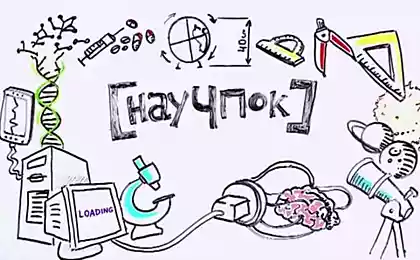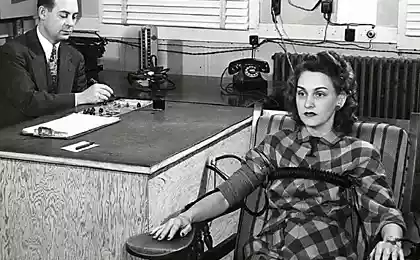702
These SPECIAL exercises will help to cope with DIZZINESS
In early may I wrote the woman from Ekaterinburg, which among other things said that "literally not so long ago appeared dizziness, all examinations of the head, the vessels of the neck does not see any striking reason for this", and otoneurology put the diagnosis "otolites".
As for the Greek. "OTOs" ear, and "Litos" — stone, the term "otolites" must mean "rocks in my ears". I know about the stones in the gallbladder about kidney stones, I heard about the stones in the salivary gland (sialolithiasis) and even about Tartar (hardened plaque on the tooth surface), but about otolites learned for the first time, although diligently taught ENT disease at the time. Using search engines, found that information about italicize on the Internet is relatively small. And although this is a fairly common disease, many doctors also don't know about it and blamed dizzy for entirely different reasons. And the most interesting — otolites is well treated by special exercises even at home. And I decided to share the information in your blog. Fifty seven million six hundred sixteen thousand five hundred seventy six
The theoretical part was quite difficult, but all the nuances need to know. It is enough to imagine the symptoms and method of treatment.
A bit of theory about the perception of balance
The sound, balance and acceleration of the body is perceived in the inner ear. The sound in the cochlea. Static (fixed) posture of the body is perceived by the vestibular cells in the oval and round saccules of the vestibule. These bags are normally otoliths (crystals of calcium bicarbonate CaCO3), which in any position of the body put pressure on any group of receptors and they send electrical impulses to the brain.
Eighty one million thirty two thousand three hundred fifty
The ear is divided into outer, middle and inner.
Dynamic changes of body position (turning, acceleration) are perceived by the semicircular canals, which begin from the oval pouch (synonym — utricle, utriculus in Latin). Each semicircular canal (3) is 2 feet (base), one of the expanded, forming a so-called vial. In capsules are sensitive cells covered with gelatinous cap — copulas.
Because the semicircular canals are located in 3 mutually perpendicular planes, any movement of the head will not go unnoticed for receptors of the vestibular apparatus. When you change the position of the head endolymph moves by inertia and causes oscillations of the cupula and hairs of receptor covered it. Nerve impulses from receptors going to the brain.
Six million five hundred sixty two thousand seven hundred eighteen
Sensitive (receptor) cells are interspersed with support (support) cells (see figure). The processes of supporting cells and sensory receptor cells end immersed in a gelatinous mass, the otolithic membrane. In the upper part of the otolith membrane embedded otoliths, which increases its density doubled compared with the surrounding endolymph.
This difference of weight is necessary for the normal functioning of the receptors. If the head is exposed to acceleration, the inertial force acting on the endolymph and the otolith membrane, different due to the difference of density. Whole otolith apparatus is easy to slide by inertia on sensitive epithelium. In the result the cilia are deflected and stimulate the receptors.
Thirty six million four hundred eight thousand four hundred seventy six
Thirty six million three hundred fourteen thousand five hundred twenty eight
From receptors of the vestibular apparatus, nerve impulses go to the brain. The centers of the vestibular analyzer is closely associated with the centers of the oculomotor nerve in the midbrain, which explains the illusion of motion of objects in a circle after we stop the rotation.
Vestibular centres is also closely associated with the cerebellum and the hypothalamus, causing motion sickness when the person loses coordination of movements and nausea. Ends of the vestibular analyzer in the cerebral cortex. Part of the cortex in the implementation of the voluntary movements allows us to control the body in space.
What is otolites?
Otolites also called DPPG — benign paroxysmal positional vertigo. The word "paroxysmal" means "in the form of attacks", "attacks", and the word "position" underlines the dependence of the beginning of the seizure of body position, posture, "positions". In other words, otolites manifests itself in the form of attacks of vertigo when the head is in certain positions.
When utilitize the otolith membrane for reasons unknown damaged with the formation of the moving fragments, which move freely and penetrate into the endolymph of the semicircular canals, most often the back, like most low-lying. Allocate 2 types of otolites:
In 50-75% of cases the cause of otolites is unknown (idiopathic form), in other cases, there are:
Symptoms of otolites
For utilitiesa characterized by sudden intense vertigo (sensation of rotation of objects around the patient) by changing the position of the head and body. Dizziness most often occurs in the morning after waking or at night when turning in bed. The dizziness lasts no more than 1-2 minutes (but the patient may feel longer). If you experience dizziness, the patient returned to its original position, the dizziness stops faster.
To provoke the attack may also crowding the head back and tilts down (pay attention to these movements), so the majority of patients, experimentally identifying this effect, try to make "dangerous" moves slowly or not to use the plane of the affected canal. As typical of peripheral vertigo, attack of otolites may be accompanied by nausea (rarely vomiting).
Positional vertigo with DPPG most pronounced after waking up, and then during the day usually decreases. When canalolithiasis this is due to the partial russianemergencies clot in the semicircular canal at the first movement of his head, and their weight is not enough to create the effect of the same force, so the repeated bending positional vertigo is reduced.
In addition to the dizziness, bouts of otolites characterized by the presence of nystagmus (involuntary rapid rhythmic movement of the eyes). Positional nystagmus is of great diagnostic value, since the characteristic movements of the eye specialist will easily identify the problematic semicircular canal. During the attack DPPG nystagmus and vertigo occur simultaneously, diminish and disappear. The duration of the positional nystagmus to canalolithiasis the front and rear channel does not exceed 30-40 C, for canalolithiasis horizontal channel — 1-2 min. Cupulolithiasis is characterized by a long positional nystagmus.
Typical DPPG nystagmus is always some delay, due to the viscosity of the endolymph (compare the speed of fall of a stone in air and in water). The delay also has a certain value (for pathology of the horizontal channel, it is equal to 1-2 C, for posterior and anterior semicircular canals up to 3-4 C).
Diagnosis of otolites
To confirm the diagnosis of DPPG is a test of Diks-Helpica. The patient sits on the couch, his gaze fixed on the forehead of the doctor. The doctor turns the patient's head in a certain direction (e.g., right) approximately 45° and then sharply puts him on his back, with the head tilt for 30° back (head hangs off the couch), keeping the pivot at 45° to the side. If a positive sample after a short latent period of 1-5 seconds there dizziness and nystagmus. If you test with head rotation to the right gives a negative answer, it must be repeated with head rotation to the left.
http://cdn00.vidyomani.com/c/8/7/8/wn72rw3u8syx/index.html
SUBSCRIBE to OUR youtube channel that allows you to watch online, download from YouTube free video about the recovery, the rejuvenation of man. Love for others and ourselves, as the feeling of high vibrations — an important factor for improvement .
The doctor monitors eye movements of the patient and asks him if there is dizziness. The patient advance warning of the possibility of his usual vertigo and that this condition is reversible and safe.
In formulating the diagnosis of DPPG shall indicate the affected side (left, right) and semicircular canal (posterior, anterior, outer). For example: "otolites posterior semicircular canal of the left ear".
Currently DPPG is one of the most common causes of vertigo associated with disorders of the inner ear, and is about 25% of all peripheral vestibular vertigo.
Of vertigo are peripheral and Central:
2. diplopia (double vision),
3. paresthesia (unusual sensation of numbness of the skin, "pins and needles", tingling that occurs without external influence),
4. headache,
5. weakness,
6. ataxia (disorder of coordination of voluntary movements) of the limbs.
Problems in diagnosing dizziness
Osteochondrosis
Dizziness is often attributed to cervical osteochondrosis. If you make x-rays of the spine, the diagnosis of "degenerative disc disease" can be put to any elderly person. Pathological changes there 100% of the population of this age, but to give "pain" for the cause of the dizziness will be the absolute error.
Vertebral-basilar insufficiency
Slightly more reasonable (but also mistakenly) doctors blamed vertigo in vascular vertebral-basilar insufficiency (VBN that occurs when blood flow to the brain via the vertebral arteries) caused by atherosclerosis or congenital tortuosity of blood vessels, explaining to the patient: "you turn your head, the vessels are clamped and the blood ceases to flow to the brain, causing dizzy".
Theory: how the brain is supplied.
Seventy six million six hundred forty eight thousand eight hundred fifty two
Blood supply of the brain (bottom view).
From the aortic arch (1) turns away brachiocephalic trunk (2), left common carotid artery and left subclavian artery (3). On each side the common carotid artery (right — 4) is divided into the outer (right — 6) and internal. The internal carotid artery (left — 7) go to the brain and supply blood to his anterior and eye (ophthalmic artery — 9).
From the subclavian artery on each side departs the vertebral artery (left vertebral artery — 5). The vertebral artery passes in the holes of the transverse processes of the cervical vertebrae. In the cranial cavity at the base of the brain 2 vertebral arteries merge into one basilar (main) artery (8).
Two internal carotid artery madinaguda between them and the basilar artery via the connecting branches, in 25-50% of cases forming an arterial ring — the circle of Willis, which allows parts of the brain do not die if the blood flow through 1 of the 4 arteries to the brain is suddenly stopped. In chronic circulatory disorders of the brain in the vertebral artery occurs, the vertebral-basilar insufficiency.
In fact, dizziness is very rarely caused by VBN (there are known cases of surgical operations on straightening the tortuous vertebral artery, which did not bring the expected effect of eliminating dizziness). When the vertebral-basilar insufficiency, the dizziness may not be the only symptom, because it affects all anatomical structures, perfused from the vertebral and basilar arteries. Dizziness when VBN lasts from a few seconds to minutes and is accompanied by:
Orthostatic hypotension
Dizziness occurs when orthostatic hypotension (a sharp drop in blood pressure with possible loss of consciousness during the transition from horizontal to vertical), such as the effect of the first dose when taking alpha-blockers. Dizziness with orthostatic hypotension is accompanied by a sensation of spots before eyes, is not accompanied by nystagmus and occurs only during tilting and crowding of the head. For proper diagnosis you should compare the blood pressure with the patient supine and standing.
Treatment of otolites
Over the last 20 years significant progress has been made in the treatment of otolites. If earlier patients with recommended to avoid the "dangerous" provisions, and the treatment was only symptomatic, now developed methods allowing the fragments of the otoconia back into an oval pouch. In some cases, benign paroxysmal positional vertigo (otolites) cured a good maneuver for a couple of minutes. In other cases, exercise has to be repeated a few days 1-3 times a day.
By the way, "purity" in the name of DPPG due to its sudden disappearance (regardless of medical treatment). This is usually associated with the dissolution of the freely moving particles in the endolymph, particularly in the decrease in the concentration of calcium. Also particles can move into the sacs of the vestibule, although alone it is much less common.
Here is the exercise that can be used by patients and physicians for the treatment of vertigo in italicize.
1. The Method Of Brandt-Daroff. It is generally recommended to patients for self-application.
According to this method, the patient is recommended to perform the exercises three times a day for 5 times in both directions in one session. If dizziness occurs at least once in the morning in any position, the exercises are repeated in the afternoon and evening. To perform the technique, the patient needs after waking up to sit in the center of the bed, his legs dangling down. Then he laid on any side, with the head turned upward at 45°, and is in this position 30 (or until, until no vertigo).
After that, the patient returns to the original sitting position, in which the stays 30, and then quickly placed on the opposite side, turning his head upwards at 45°. After 30 it takes the original sitting position. In the morning the patient performs five repetitive slopes on both sides. If dizziness occurred at least once in any position, the slopes must be repeated in the afternoon and evening.
http://cdn00.vidyomani.com/c/8/7/9/ul8708t9ao64/index.html Example exercises according to the method of Brandt-Daroff (explanations in English).
SUBSCRIBE to OUR youtube channel that allows you to watch online, download from YouTube free video about the recovery, the rejuvenation of man. Love for others and ourselves, as the feeling of high vibrations — an important factor for improvement .
The duration of such therapy is selected individually. The effectiveness of this technique for the relief of benign paroxysmal positional vertigo is about 60%. You can complete the exercises if positional vertigo arising from the conduct of exercises Brandt-Daroff not repeated in 2-3 days.
Other therapeutic maneuvers require the direct involvement of the attending physician. Their efficiency can reach 95%, but it may result in vertigo with nausea and vomiting, therefore patients with diseases of the cardiovascular system maneuvers performed with caution and pre-appointment of betahistine (24 mg as a single dose 1 h before performing the maneuver).
2. The Semont Maneuver.
Is performed with the help of a physician or independently. Starting position: sitting on the couch, legs hang down down. Sitting patient turns the head in the horizontal plane at 45° to the healthy side. Then, locking his hands to his head, the patient is placed on his side, the affected side. In this position he remains until there is no further dizziness. Then the doctor quickly moving your center of gravity and continuing to fix the patient's head in the same plane, puts the patient on the other side through the position "sitting" without changing the position of the patient's head (i.e., forehead down). The patient remains in this position until dizziness disappears. Next, without changing the position of the head of the patient, his seat on the couch. If necessary, you can repeat the maneuver.
3. The Epley maneuver (in pathology of the posterior semicircular canal).
It is advisable to have it performed by a doctor. It features a clear trajectory, moving slowly from one position to another. Starting position the patient — sitting along the couch. Previously the patient's head is rotated 45° in the direction of pathology. The doctor fixes the patient's head in this position. Next, the patient is placed on his back, head thrown back 45°. Next turn the fixed head in the opposite direction in the same position on the couch. Then the patient is placed on the side, and your head turn a healthy ear down. Then the patient sits, the head inclined and turned to the side of the pathology, after which she returned to a familiar position — ahead gaze. Stay patient in each situation is determined individually, depending on the severity of the Vestibulo-ocular reflex. Many experts use additional funds to accelerate the deposition of freely moving particles, which increases the effectiveness of treatment. As a rule, 2-4 maneuvers during a single treatment session is enough to completely stop the DPPG.
4. Maneuver Lampert (in pathology of the horizontal semicircular canal).
It is desirable to fulfill the doctor. Starting position the patient — sitting along the couch. The doctor fixes the patient's head during the maneuver. The head rotated 45° to the horizontal plane in the direction of pathology. Then the patient laid on his back, consistently turning the head to the opposite side, and then on the healthy side the head, respectively, turning the healthy ear down. Further in the same direction to turn the patient's body and placed it over the abdomen; the head gives the position of the nose downwards; as you turn the head turns on. Following this, the patient is placed on the opposite side; the head — the patient's ear from top to bottom, seated the patient on the couch using the healthy side. The maneuver can be repeated.
After the maneuver is important to ensure that patients limit mode tilt, and in the first night to sleep with our heads elevated at 45-60° (use several pillows). Recurrence of benign paroxysmal positional vertigo occurs in less than 6-8% of patients, so the recommendation is limited to the adherence of the slopes.
Recently created special chairs with the possibility of fixation of the patient, 2-axis, electronic drive with remote control and possibility of mechanical rotation in emergency situations. They allow the individual to form the therapeutic maneuver, just by moving the patient in the plane of any semicircular canal 360° with possibility of step stops the rotation. The effectiveness of the maneuver on such a chair increases to the maximum and generally does not require repetition.
The efficiency of maneuvers (exercises) are significantly higher in patients with canalolithiasis occurring more often than cupulolithiasis. When cupulolithiasis exercises usually require repetition and combination of different maneuvers. In special cases, exercises Brandt-Daroff can be recommended for self-fulfillment in the long term with the goal of creating adaptation.
In 1-2% of all patients with benign paroxysmal positional vertigo exercises and maneuvers are ineffective. In such cases, do surgery.
In the case of DPPG first of all:
Other causes of dizziness
In addition to the above otolites, vertebral-basilar insufficiency and orthostatic hypotension, there may be other causes of dizziness:
Otoneurologic very little. In Moscow only 7 otoneurologic, is closely involved in vertigo. In Europe and the US experts too little, but there are specialized clinics or offices that specializes in vestibular disorders. Now attempt to open such a center in Moscow at the clinic of nervous diseases.
Afterword
I recommended the patient, from which I first learned about autolites, exercises for self-fulfillment. Recently came from her email:
I apologize that at once did not answer — I got carried away with the exercises you sent references. The result is, that after every fold as disgusting-sickness. In General, it is not an entertainment. So Your email is not immediately answered. The dizziness go away. I no longer do, and they after a few days I return again and all over again. But I still hope, if everything is done in the system and quite long — would be a sustainable result.
I hope she will be fine.published
Put LIKES and share with your FRIENDS
www.youtube.com/channel/UCXd71u0w04qcwk32c8kY2BA/videos
Subscribe -https://www.facebook.com//
See also:
It is necessary to know! 6 stages of slagging of the organism
Muse! The most insidious enemy of Your body
P. S. And remember, only by changing their consumption — together we change the world! ©
Join us in Facebook , Vkontakte, Odnoklassniki
Source: www.happydoctor.ru/info/1378
As for the Greek. "OTOs" ear, and "Litos" — stone, the term "otolites" must mean "rocks in my ears". I know about the stones in the gallbladder about kidney stones, I heard about the stones in the salivary gland (sialolithiasis) and even about Tartar (hardened plaque on the tooth surface), but about otolites learned for the first time, although diligently taught ENT disease at the time. Using search engines, found that information about italicize on the Internet is relatively small. And although this is a fairly common disease, many doctors also don't know about it and blamed dizzy for entirely different reasons. And the most interesting — otolites is well treated by special exercises even at home. And I decided to share the information in your blog. Fifty seven million six hundred sixteen thousand five hundred seventy six
The theoretical part was quite difficult, but all the nuances need to know. It is enough to imagine the symptoms and method of treatment.
A bit of theory about the perception of balance
The sound, balance and acceleration of the body is perceived in the inner ear. The sound in the cochlea. Static (fixed) posture of the body is perceived by the vestibular cells in the oval and round saccules of the vestibule. These bags are normally otoliths (crystals of calcium bicarbonate CaCO3), which in any position of the body put pressure on any group of receptors and they send electrical impulses to the brain.
Eighty one million thirty two thousand three hundred fifty
The ear is divided into outer, middle and inner.
Dynamic changes of body position (turning, acceleration) are perceived by the semicircular canals, which begin from the oval pouch (synonym — utricle, utriculus in Latin). Each semicircular canal (3) is 2 feet (base), one of the expanded, forming a so-called vial. In capsules are sensitive cells covered with gelatinous cap — copulas.
Because the semicircular canals are located in 3 mutually perpendicular planes, any movement of the head will not go unnoticed for receptors of the vestibular apparatus. When you change the position of the head endolymph moves by inertia and causes oscillations of the cupula and hairs of receptor covered it. Nerve impulses from receptors going to the brain.
Six million five hundred sixty two thousand seven hundred eighteen
Sensitive (receptor) cells are interspersed with support (support) cells (see figure). The processes of supporting cells and sensory receptor cells end immersed in a gelatinous mass, the otolithic membrane. In the upper part of the otolith membrane embedded otoliths, which increases its density doubled compared with the surrounding endolymph.
This difference of weight is necessary for the normal functioning of the receptors. If the head is exposed to acceleration, the inertial force acting on the endolymph and the otolith membrane, different due to the difference of density. Whole otolith apparatus is easy to slide by inertia on sensitive epithelium. In the result the cilia are deflected and stimulate the receptors.
Thirty six million four hundred eight thousand four hundred seventy six
Thirty six million three hundred fourteen thousand five hundred twenty eight
From receptors of the vestibular apparatus, nerve impulses go to the brain. The centers of the vestibular analyzer is closely associated with the centers of the oculomotor nerve in the midbrain, which explains the illusion of motion of objects in a circle after we stop the rotation.
Vestibular centres is also closely associated with the cerebellum and the hypothalamus, causing motion sickness when the person loses coordination of movements and nausea. Ends of the vestibular analyzer in the cerebral cortex. Part of the cortex in the implementation of the voluntary movements allows us to control the body in space.
What is otolites?
Otolites also called DPPG — benign paroxysmal positional vertigo. The word "paroxysmal" means "in the form of attacks", "attacks", and the word "position" underlines the dependence of the beginning of the seizure of body position, posture, "positions". In other words, otolites manifests itself in the form of attacks of vertigo when the head is in certain positions.
When utilitize the otolith membrane for reasons unknown damaged with the formation of the moving fragments, which move freely and penetrate into the endolymph of the semicircular canals, most often the back, like most low-lying. Allocate 2 types of otolites:
- canalolithiasis (common) — fragments, freely arranged in the form of a bundle to the smooth part of the semicircular canal,
- cupulolithiasis (rarely) — fixed the fragments of the cupula in the ampulla of one of the semicircular canals.
In 50-75% of cases the cause of otolites is unknown (idiopathic form), in other cases, there are:
- injury,
- nigrolabiata (inflammation of the labyrinth),
- Meniere's disease,
- surgical operations (on-ear, and General surgery).
Symptoms of otolites
For utilitiesa characterized by sudden intense vertigo (sensation of rotation of objects around the patient) by changing the position of the head and body. Dizziness most often occurs in the morning after waking or at night when turning in bed. The dizziness lasts no more than 1-2 minutes (but the patient may feel longer). If you experience dizziness, the patient returned to its original position, the dizziness stops faster.
To provoke the attack may also crowding the head back and tilts down (pay attention to these movements), so the majority of patients, experimentally identifying this effect, try to make "dangerous" moves slowly or not to use the plane of the affected canal. As typical of peripheral vertigo, attack of otolites may be accompanied by nausea (rarely vomiting).
Positional vertigo with DPPG most pronounced after waking up, and then during the day usually decreases. When canalolithiasis this is due to the partial russianemergencies clot in the semicircular canal at the first movement of his head, and their weight is not enough to create the effect of the same force, so the repeated bending positional vertigo is reduced.
In addition to the dizziness, bouts of otolites characterized by the presence of nystagmus (involuntary rapid rhythmic movement of the eyes). Positional nystagmus is of great diagnostic value, since the characteristic movements of the eye specialist will easily identify the problematic semicircular canal. During the attack DPPG nystagmus and vertigo occur simultaneously, diminish and disappear. The duration of the positional nystagmus to canalolithiasis the front and rear channel does not exceed 30-40 C, for canalolithiasis horizontal channel — 1-2 min. Cupulolithiasis is characterized by a long positional nystagmus.
Typical DPPG nystagmus is always some delay, due to the viscosity of the endolymph (compare the speed of fall of a stone in air and in water). The delay also has a certain value (for pathology of the horizontal channel, it is equal to 1-2 C, for posterior and anterior semicircular canals up to 3-4 C).
Diagnosis of otolites
To confirm the diagnosis of DPPG is a test of Diks-Helpica. The patient sits on the couch, his gaze fixed on the forehead of the doctor. The doctor turns the patient's head in a certain direction (e.g., right) approximately 45° and then sharply puts him on his back, with the head tilt for 30° back (head hangs off the couch), keeping the pivot at 45° to the side. If a positive sample after a short latent period of 1-5 seconds there dizziness and nystagmus. If you test with head rotation to the right gives a negative answer, it must be repeated with head rotation to the left.
http://cdn00.vidyomani.com/c/8/7/8/wn72rw3u8syx/index.html
SUBSCRIBE to OUR youtube channel that allows you to watch online, download from YouTube free video about the recovery, the rejuvenation of man. Love for others and ourselves, as the feeling of high vibrations — an important factor for improvement .
The doctor monitors eye movements of the patient and asks him if there is dizziness. The patient advance warning of the possibility of his usual vertigo and that this condition is reversible and safe.
In formulating the diagnosis of DPPG shall indicate the affected side (left, right) and semicircular canal (posterior, anterior, outer). For example: "otolites posterior semicircular canal of the left ear".
Currently DPPG is one of the most common causes of vertigo associated with disorders of the inner ear, and is about 25% of all peripheral vestibular vertigo.
Of vertigo are peripheral and Central:
- peripheral vertigo is caused by pathology of the vestibular analyzer outside of the brain. They are often, but typically do not reach pronounced degree, since the brain adapts to incorrect operation of the power pulses.
- Central vertigo arise from lesions of brain structures, most often of the medulla oblongata and the cerebellum. They are often combined with other manifestations:
2. diplopia (double vision),
3. paresthesia (unusual sensation of numbness of the skin, "pins and needles", tingling that occurs without external influence),
4. headache,
5. weakness,
6. ataxia (disorder of coordination of voluntary movements) of the limbs.
Problems in diagnosing dizziness
Osteochondrosis
Dizziness is often attributed to cervical osteochondrosis. If you make x-rays of the spine, the diagnosis of "degenerative disc disease" can be put to any elderly person. Pathological changes there 100% of the population of this age, but to give "pain" for the cause of the dizziness will be the absolute error.
Vertebral-basilar insufficiency
Slightly more reasonable (but also mistakenly) doctors blamed vertigo in vascular vertebral-basilar insufficiency (VBN that occurs when blood flow to the brain via the vertebral arteries) caused by atherosclerosis or congenital tortuosity of blood vessels, explaining to the patient: "you turn your head, the vessels are clamped and the blood ceases to flow to the brain, causing dizzy".
Theory: how the brain is supplied.
Seventy six million six hundred forty eight thousand eight hundred fifty two
Blood supply of the brain (bottom view).
From the aortic arch (1) turns away brachiocephalic trunk (2), left common carotid artery and left subclavian artery (3). On each side the common carotid artery (right — 4) is divided into the outer (right — 6) and internal. The internal carotid artery (left — 7) go to the brain and supply blood to his anterior and eye (ophthalmic artery — 9).
From the subclavian artery on each side departs the vertebral artery (left vertebral artery — 5). The vertebral artery passes in the holes of the transverse processes of the cervical vertebrae. In the cranial cavity at the base of the brain 2 vertebral arteries merge into one basilar (main) artery (8).
Two internal carotid artery madinaguda between them and the basilar artery via the connecting branches, in 25-50% of cases forming an arterial ring — the circle of Willis, which allows parts of the brain do not die if the blood flow through 1 of the 4 arteries to the brain is suddenly stopped. In chronic circulatory disorders of the brain in the vertebral artery occurs, the vertebral-basilar insufficiency.
In fact, dizziness is very rarely caused by VBN (there are known cases of surgical operations on straightening the tortuous vertebral artery, which did not bring the expected effect of eliminating dizziness). When the vertebral-basilar insufficiency, the dizziness may not be the only symptom, because it affects all anatomical structures, perfused from the vertebral and basilar arteries. Dizziness when VBN lasts from a few seconds to minutes and is accompanied by:
- symptoms of blurred vision (blurring of vision, tubular vision — constriction of peripheral fields of view), because the visual centre in the occipital areas of the cerebral cortex;
- hearing for sensorineural (sound), because the inner ear gets it blood supply from the labyrinthine artery, which departs from the basilar (main) artery.
Orthostatic hypotension
Dizziness occurs when orthostatic hypotension (a sharp drop in blood pressure with possible loss of consciousness during the transition from horizontal to vertical), such as the effect of the first dose when taking alpha-blockers. Dizziness with orthostatic hypotension is accompanied by a sensation of spots before eyes, is not accompanied by nystagmus and occurs only during tilting and crowding of the head. For proper diagnosis you should compare the blood pressure with the patient supine and standing.
Treatment of otolites
Over the last 20 years significant progress has been made in the treatment of otolites. If earlier patients with recommended to avoid the "dangerous" provisions, and the treatment was only symptomatic, now developed methods allowing the fragments of the otoconia back into an oval pouch. In some cases, benign paroxysmal positional vertigo (otolites) cured a good maneuver for a couple of minutes. In other cases, exercise has to be repeated a few days 1-3 times a day.
By the way, "purity" in the name of DPPG due to its sudden disappearance (regardless of medical treatment). This is usually associated with the dissolution of the freely moving particles in the endolymph, particularly in the decrease in the concentration of calcium. Also particles can move into the sacs of the vestibule, although alone it is much less common.
Here is the exercise that can be used by patients and physicians for the treatment of vertigo in italicize.
1. The Method Of Brandt-Daroff. It is generally recommended to patients for self-application.
According to this method, the patient is recommended to perform the exercises three times a day for 5 times in both directions in one session. If dizziness occurs at least once in the morning in any position, the exercises are repeated in the afternoon and evening. To perform the technique, the patient needs after waking up to sit in the center of the bed, his legs dangling down. Then he laid on any side, with the head turned upward at 45°, and is in this position 30 (or until, until no vertigo).
After that, the patient returns to the original sitting position, in which the stays 30, and then quickly placed on the opposite side, turning his head upwards at 45°. After 30 it takes the original sitting position. In the morning the patient performs five repetitive slopes on both sides. If dizziness occurred at least once in any position, the slopes must be repeated in the afternoon and evening.
http://cdn00.vidyomani.com/c/8/7/9/ul8708t9ao64/index.html Example exercises according to the method of Brandt-Daroff (explanations in English).
SUBSCRIBE to OUR youtube channel that allows you to watch online, download from YouTube free video about the recovery, the rejuvenation of man. Love for others and ourselves, as the feeling of high vibrations — an important factor for improvement .
The duration of such therapy is selected individually. The effectiveness of this technique for the relief of benign paroxysmal positional vertigo is about 60%. You can complete the exercises if positional vertigo arising from the conduct of exercises Brandt-Daroff not repeated in 2-3 days.
Other therapeutic maneuvers require the direct involvement of the attending physician. Their efficiency can reach 95%, but it may result in vertigo with nausea and vomiting, therefore patients with diseases of the cardiovascular system maneuvers performed with caution and pre-appointment of betahistine (24 mg as a single dose 1 h before performing the maneuver).
2. The Semont Maneuver.
Is performed with the help of a physician or independently. Starting position: sitting on the couch, legs hang down down. Sitting patient turns the head in the horizontal plane at 45° to the healthy side. Then, locking his hands to his head, the patient is placed on his side, the affected side. In this position he remains until there is no further dizziness. Then the doctor quickly moving your center of gravity and continuing to fix the patient's head in the same plane, puts the patient on the other side through the position "sitting" without changing the position of the patient's head (i.e., forehead down). The patient remains in this position until dizziness disappears. Next, without changing the position of the head of the patient, his seat on the couch. If necessary, you can repeat the maneuver.
3. The Epley maneuver (in pathology of the posterior semicircular canal).
It is advisable to have it performed by a doctor. It features a clear trajectory, moving slowly from one position to another. Starting position the patient — sitting along the couch. Previously the patient's head is rotated 45° in the direction of pathology. The doctor fixes the patient's head in this position. Next, the patient is placed on his back, head thrown back 45°. Next turn the fixed head in the opposite direction in the same position on the couch. Then the patient is placed on the side, and your head turn a healthy ear down. Then the patient sits, the head inclined and turned to the side of the pathology, after which she returned to a familiar position — ahead gaze. Stay patient in each situation is determined individually, depending on the severity of the Vestibulo-ocular reflex. Many experts use additional funds to accelerate the deposition of freely moving particles, which increases the effectiveness of treatment. As a rule, 2-4 maneuvers during a single treatment session is enough to completely stop the DPPG.
4. Maneuver Lampert (in pathology of the horizontal semicircular canal).
It is desirable to fulfill the doctor. Starting position the patient — sitting along the couch. The doctor fixes the patient's head during the maneuver. The head rotated 45° to the horizontal plane in the direction of pathology. Then the patient laid on his back, consistently turning the head to the opposite side, and then on the healthy side the head, respectively, turning the healthy ear down. Further in the same direction to turn the patient's body and placed it over the abdomen; the head gives the position of the nose downwards; as you turn the head turns on. Following this, the patient is placed on the opposite side; the head — the patient's ear from top to bottom, seated the patient on the couch using the healthy side. The maneuver can be repeated.
After the maneuver is important to ensure that patients limit mode tilt, and in the first night to sleep with our heads elevated at 45-60° (use several pillows). Recurrence of benign paroxysmal positional vertigo occurs in less than 6-8% of patients, so the recommendation is limited to the adherence of the slopes.
Recently created special chairs with the possibility of fixation of the patient, 2-axis, electronic drive with remote control and possibility of mechanical rotation in emergency situations. They allow the individual to form the therapeutic maneuver, just by moving the patient in the plane of any semicircular canal 360° with possibility of step stops the rotation. The effectiveness of the maneuver on such a chair increases to the maximum and generally does not require repetition.
The efficiency of maneuvers (exercises) are significantly higher in patients with canalolithiasis occurring more often than cupulolithiasis. When cupulolithiasis exercises usually require repetition and combination of different maneuvers. In special cases, exercises Brandt-Daroff can be recommended for self-fulfillment in the long term with the goal of creating adaptation.
In 1-2% of all patients with benign paroxysmal positional vertigo exercises and maneuvers are ineffective. In such cases, do surgery.
In the case of DPPG first of all:
- to limit the movement,
- choose a comfortable position lying,
- try less to turn over in bed and to rise so as not to cause dizziness;
- try as early as possible to get on reception to the doctor (neurologist or otoneurology), which can be reached in any way, just not in the car.
Other causes of dizziness
In addition to the above otolites, vertebral-basilar insufficiency and orthostatic hypotension, there may be other causes of dizziness:
- herpes infection: herpes virus damages the vestibular nerve. More often in young people. Takes place a few days (the brain compensates for the nerve damage), but many patients over this time to an erroneous diagnosis of "stroke".
- Meniere's disease (accent on the second syllable, as in describing the disease the doctor was a Frenchman): dizziness, hearing loss, tinnitus. Due to the increase in pressure (fluid) in the cavity of the inner ear.
- vestibular migraine: a rare form of migraine with vertigo without headaches and hearing loss. Effective the usual migraine medications (analgesics, sumatriptan, dihydroergotamine).
- neurotic disorders and depression: for example, discomfort with agoraphobia (fear of open spaces) can be accepted by the patient for dizziness.
Otoneurologic very little. In Moscow only 7 otoneurologic, is closely involved in vertigo. In Europe and the US experts too little, but there are specialized clinics or offices that specializes in vestibular disorders. Now attempt to open such a center in Moscow at the clinic of nervous diseases.
Afterword
I recommended the patient, from which I first learned about autolites, exercises for self-fulfillment. Recently came from her email:
I apologize that at once did not answer — I got carried away with the exercises you sent references. The result is, that after every fold as disgusting-sickness. In General, it is not an entertainment. So Your email is not immediately answered. The dizziness go away. I no longer do, and they after a few days I return again and all over again. But I still hope, if everything is done in the system and quite long — would be a sustainable result.
I hope she will be fine.published
Put LIKES and share with your FRIENDS
www.youtube.com/channel/UCXd71u0w04qcwk32c8kY2BA/videos
Subscribe -https://www.facebook.com//
See also:
It is necessary to know! 6 stages of slagging of the organism
Muse! The most insidious enemy of Your body
P. S. And remember, only by changing their consumption — together we change the world! ©
Join us in Facebook , Vkontakte, Odnoklassniki
Source: www.happydoctor.ru/info/1378
Delicious soup from young cabbage
Reactive water heating oven oven sverhekonomnoe of the available materials






















